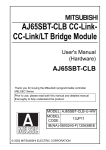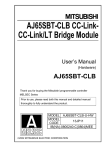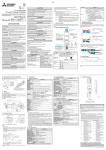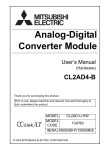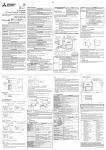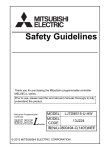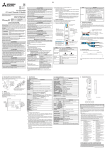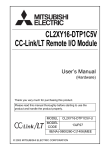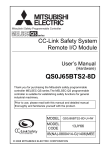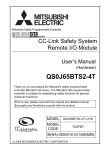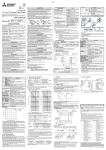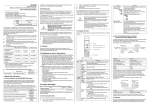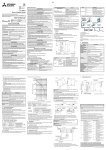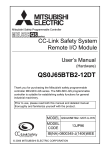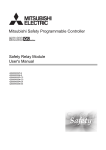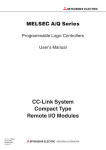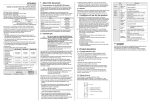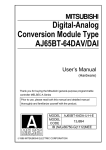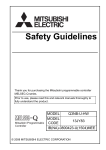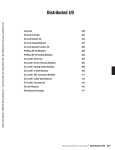Download AJ65SBT-CLB CC-Link - CC-Link/LT Bridge Module User`s Manual
Transcript
AJ65SBT-CLB CC-LinkCC-Link/LT Bridge Module
User's Manual
(Hardware)
AJ65SBT-CLB
Thank you for buying the Mitsubishi programmable controller
MELSEC Series
Prior to use, please read both this manual and detailed manual
thoroughly to fully understand the product.
MODEL AJ65SBT-CLB-U-HW
MODEL
13JP11
CODE
IB(NA)-0800240-G(1406)MEE
© 2002 MITSUBISHI ELECTRIC CORPORATION
SAFETY PRECAUTIONS
(Read these precautions before using this product.)
Before using this product, please read this manual and the relevant manuals
carefully and pay full attention to safety to handle the product correctly.
These precautions apply only to this equipment.
Refer to the user's manual of the CPU module to use for a description of the
programmable controller system safety precautions.
In this manual, the safety precautions are classified into two levels:
"
WARNING " and "
CAUTION".
WARNING
Indicates that incorrect handling may cause
hazardous conditions, resulting in death or severe
injury.
CAUTION
Indicates that incorrect handling may cause
hazardous conditions, resulting in minor or moderate
injury or property damage.
Under some circumstances, failure to observe the precautions given under
"
CAUTION" may lead to serious consequences.
Observe the precautions of both levels because they are important for personal
and system safety.
Make sure that the end users read this manual and then keep the manual in a safe
place for future reference.
[Design Precautions]
WARNING
● When there are communication problems with the data link, the data for the
master module will be held.
Configure an interlocking circuit in a sequence program so that the safety of
the overall system is always maintained.
A-1
[Design Precautions]
CAUTION
● Do not bunch the control wires or communication cables with the main circuit
or power wires, or install them close to each other.
They should be installed 100mm (3.9inch) or more from each other.
Not doing so could result in noise that would cause erroneous operation.
● Do not write data to the "reserved areas" of the remote I/O and remote
devices.
Doing so can pose the risk of malfunctioning the product.
[Installation Precautions]
CAUTION
● Use each product in an environment as specified in the "general
specification" in the detailed manual.
Using the programmable controller outside the range of the general
specifications may result in electric shock, fire or malfunction, or may damage
or degrade the product.
● Securely fix the product to a DIN rail or securely fix it with the Module
mounting screw.
Not doing so can cause a drop or malfunction.
● Do not touch the conducted area or electric parts of the product.
Doing so may cause product malfunctioning or breakdowns.
A-2
[Wiring Precautions]
CAUTION
● For the CC-Link/LT, use the cables specified by the CC-Link Partner
Association. The performance of the CC-Link/LT cannot be assured if any
other cables than the specified are used.
Also, observe the network wiring specifications given in Chapter 2. Normal
data communication is not guaranteed if the wiring is not conducted according
to the specifications.
● Be sure to shut off all phases of the external power supply used by the system
before installation or wiring.
Not doing so can cause the product to be damaged or malfunction.
● Always ground the FG terminal to the protective ground conductor.
Not doing so can cause a malfunction.
● Tighten the terminal screws within the specified torque range. Undertightening
can cause short circuit, or malfunction. Overtightening can cause damage to
the screw and/or the module, resulting in drop, short circuit, or malfunction.
● Wire the product correctly after confirming the rated voltage and pin layout of
the product.
Not doing so can cause a fire or failure.
● Ensure that no foreign matter such as chips and wire-offcuts enter the
product.
Foreign matter can cause a fire, failure or malfunction.
● Be sure to fix the wires or cables by ducts or clamps when connecting them to
the module. Failure to do so may cause damage of the module or the cables
due to accidental pull or unintentional shifting of the cables, or malfunctions
due to poor contact of the cable.
● Do not install the control lines together with the communication cables, or
bring them close to each other. Failure to do so may cause malfunctions due
to noise.
● When disconnecting the communication and power supply cables from the
module, do not hold and pull the cable part.
Disconnect the cables after loosening the screws in the portions connected to
the module. Pulling the cables connected to the module can damage the
module and cables or can cause a malfunction due to a cable connection
fault.
A-3
[Starting and Maintenance Precautions]
CAUTION
● Do not touch the pin while the power is on. Doing so may cause malfunction.
● Be sure to shut off all phases of the external power supply used by the system
before cleaning.
Not doing so can cause the product to fail or malfunction.
● Never disassemble or modify the product.
This may cause breakdowns, malfunctioning, injury and/or fire.
● Do not drop the product or give it hard impact since its case is made of resin.
Doing so can damage the product.
● Be sure to shut off all phases of the external power supply used by the system
before mounting or dismounting the product to or from the panel.
Not doing so can cause the product to fail or malfunction.
● Before handling the module, touch a conducting object such as a grounded
metal to discharge the static electricity from the human body. Failure to do so
may cause the module to fail or malfunction.
[Disposal Precautions]
CAUTION
● When disposing of this product, treat it as industrial waste.
A-4
PRÉCAUTIONS DE SÉCURITÉ
(Lire ces précautions avant toute utilisation du produit.)
Avant d'utiliser ce produit, lire attentivement ce manuel ainsi que les manuels
auxquels il renvoie, et toujours considérer la sécurité comme de la plus haute
importance en manipulant le produit correctement.
Ces précautions ne concernent que cet équipement.
Dans le manuel de l'utilisateur du module CPU correspondant, voir l'exposé des
précautions de sécurité concernant le système de l'automate programmable.
Dans ce manuel, les précautions de sécurité sont classées en deux niveaux, à
savoir : "AVERTISSEMENT" et "ATTENTION"
AVERTISSEMENT
ATTENTION
Attire l'attention sur le fait qu'une négligence peut
créer une situation de danger avec risque de mort
ou de blessures graves.
Attire l'attention sur le fait qu'une négligence peut
créer une situation de danger avec risque de
blessures légères ou de gravité moyennes ou
risque de dégâts matériels.
Dans certaines circonstances, le non-respect d'une précaution de sécurité
introduite sous le titre "ATTENTION" peut avoir des conséquences graves.
Les précautions de ces deux niveaux doivent être observées dans leur intégralité
car elles ont trait à la sécurité des personnes et aussi du système.
Veiller à ce que les utilisateurs finaux lisent ce manuel qui doit être conservé
soigneusement à portée de main pour s'y référer autant que de besoin.
[Précautions lors de la conception]
AVERTISSEMENT
● En cas de problème de communication sur la liaison de données, les données
du module maître sont maintenues.
Prévoir dans le programme séquentiel un circuit de verrouillage permettant de
garantir la sécurité de l'ensemble du système en tous temps.
A-5
[Précautions lors de la conception]
ATTENTION
● Ne pas grouper les fils de commande ou câbles de communication avec les
fils des circuits principaux ou de l'alimentation, et ne pas les installer à
proximité les uns des autres.
Ils doivent être installés à une distance de 100mm (3,9 pouces) les uns des
autres.
Faute de quoi, il y a risque de bruit entraînant un fonctionnement erratique.
● N'introduire aucune donné dans les zones marquées "reserved areas" des
E/S distantes et des dispositifs distants.
Cela pourrait créer un risque de dysfonctionnement du produit.
[Précautions d'installation]
ATTENTION
● Chaque produit doit être utilisé dans un environnement conforme aux
"spécifications générales" exposées dans la documentation détaillée.
L'utilisation de l'automate programmable hors des conditions prévues dans
les spécifications générales peut être à l'origine d'un choc électrique, d'un
départ de feu ou d'un dysfonctionnement, ou peut endommager ou détériorer
le produit.
● Fixer fermement le produit sur rail DIN, ou le fixer fermement avec la vis de
fixation du module.
Faute de quoi, il y a risque de chute et de dysfonctionnements.
● Ne pas toucher ou parties conductrices ou aux organes électriques du
produit.
Cela pourrait être à l'origine de d'un dysfonctionnement du produit ou d'une
panne.
A-6
[Pécautions de câblage]
ATTENTION
● Pour les CC-Link/LT, utiliser les câbles préconisés par la CC-Link Partrner
Association. L'utilisation de câbles autres que les câbles préconisés ne
permet de garantir les performances du CC-Link/LT.
En outre, respecter les spécifications de câblage du Chapitre 2. La
communication normale des données ne peut pas être garantie si ces
prescriptions ne sont pas respectées.
● Ne pas oublier de couper toutes les phases de l'alimentation externe utilisée
par le système avant l'installation et le câblage.
Faute de quoi, il y a risque d'endommagement ou de dysfonctionnement du
produit.
● Toujours mettre à la masse la borne FG en la raccordant au conducteur de
terre.
Faute de quoi, il y a risque de dysfonctionnement.
● Serrer les vis de borne dans les limites du couple de serrage prescrit. Un
serrage insuffisant peut être à l'origine d'un court-circuit ou de
dysfonctionnements. Un serrage excessif peut endommager la vis et/ou le
module, avec aussi un risque de chute, de court-circuits et de
dysfonctionnements.
● Câbler le module correctement après avoir vérifié la tension nominale et de
l'affectation des broches du produit.
Faute de quoi, il y a risque de départ de feu ou de panne.
● Faire en sorte que les copeaux, bouts de fil et autres corps étrangers ne
pénètrent pas dans le produit.
Tout corps étranger peut être à l'origine d'un départ de feu, d'une panne ou
d'un dysfonctionnement.
● Les fils ou câbles raccordés au module doivent être placés dans des conduits
ou doivent être attachés. Faute de quoi, il y a risque d'endommagement du
module ou des câbles par ballottement ou effort de traction exercé
accidentellement sur les câbles, tout mauvais contact d'un câble pouvant être
à l'origine de dysfonctionnement.
● Ne pas installer les lignes de commande avec les câbles de communication
et ne pas les placer à proximité. Faute de quoi, les bruits parasites produiront
des dysfonctionnements.
● Pour débrancher les câbles de communication ou d'alimentation du module,
ne jamais tirer sur le câble proprement dit.
Débrancher les câbles après avoir desserré les vis sur les parties raccordées
au module. En tirant les câbles raccordés au module, on risque
d'endommager le module et/ou les câbles, ce qui peut produire des
dysfonctionnements par mauvais contact.
A-7
[Précautions de démarrage et de maintenance]
ATTENTION
● Ne pas toucher à la broche quand l'appareil est sous tension. Cela pourrait
être à l'origine de dysfonctionnements.
● Ne pas oublier de couper toutes les phases de l'alimentation externe utilisée
par le système avant le nettoyage.
Faute de quoi, il y a risque de panne ou de dysfonctionnement du produit.
● Ne jamais démonter, ni modifier le produit.
Cela pourrait être à l'origine de pannes, de dysfonctionnements, de blessures
ou d'un départ de feu.
● Ne pas faire tomber le produit ni le soumettre à des chocs car son boîtier en
plastique est fragile. Cela pourrait endommager le produit.
● Ne pas oublier de couper toutes les phases de l'alimentation externe utilisée
par le système avant de mettre le produit en place dans le tableau ou de l'en
retirer.
Faute de quoi, il y a risque de panne ou de dysfonctionnement du produit.
● Avant de manipuler un module, se débarrasser de la charge électrostatique
qu'accumule le corps humain en touchant un objet conducteur approprié. Le
non-respect de cette précaution peut être à l'origine de pannes ou de
dysfonctionnements du module.
[Précaution de mise au rebut]
ATTENTION
● Lors de sa mise au rebut, ce produit doit être traité comme un déchet
industriel.
A-8
CONDITIONS OF USE FOR THE PRODUCT
(1) Mitsubishi programmable controller ("the PRODUCT") shall be used in
conditions;
i) where any problem, fault or failure occurring in the PRODUCT, if any,
shall not lead to any major or serious accident; and
ii) where the backup and fail-safe function are systematically or
automatically provided outside of the PRODUCT for the case of any
problem, fault or failure occurring in the PRODUCT.
(2) The PRODUCT has been designed and manufactured for the purpose of
being used in general industries.
MITSUBISHI SHALL HAVE NO RESPONSIBILITY OR LIABILITY
(INCLUDING, BUT NOT LIMITED TO ANY AND ALL RESPONSIBILITY
OR LIABILITY BASED ON CONTRACT, WARRANTY, TORT, PRODUCT
LIABILITY) FOR ANY INJURY OR DEATH TO PERSONS OR LOSS OR
DAMAGE TO PROPERTY CAUSED BY the PRODUCT THAT ARE
OPERATED OR USED IN APPLICATION NOT INTENDED OR
EXCLUDED BY INSTRUCTIONS, PRECAUTIONS, OR WARNING
CONTAINED IN MITSUBISHI'S USER, INSTRUCTION AND/OR SAFETY
MANUALS, TECHNICAL BULLETINS AND GUIDELINES FOR the
PRODUCT.
("Prohibited Application")
Prohibited Applications include, but not limited to, the use of the PRODUCT
in;
• Nuclear Power Plants and any other power plants operated by Power
companies, and/or any other cases in which the public could be
affected if any problem or fault occurs in the PRODUCT.
• Railway companies or Public service purposes, and/or any other cases
in which establishment of a special quality assurance system is
required by the Purchaser or End User.
• Aircraft or Aerospace, Medical applications, Train equipment, transport
equipment such as Elevator and Escalator, Incineration and Fuel
devices, Vehicles, Manned transportation, Equipment for Recreation
and Amusement, and Safety devices, handling of Nuclear or
Hazardous Materials or Chemicals, Mining and Drilling, and/or other
applications where there is a significant risk of injury to the public or
property.
A-9
Notwithstanding the above, restrictions Mitsubishi may in its sole discretion,
authorize use of the PRODUCT in one or more of the Prohibited
Applications, provided that the usage of the PRODUCT is limited only for
the specific applications agreed to by Mitsubishi and provided further that
no special quality assurance or fail-safe, redundant or other safety features
which exceed the general specifications of the PRODUCTs are required.
For details, please contact the Mitsubishi representative in your region.
A-10
REVISIONS
*The manual number is given on the bottom right of the cover.
Print date
*Manual number
Oct.,2002
IB(NA)-0800240-A
Nov.,2004
IB(NA)-0800240-B
Revision
First edition
Correction
SAFETY PRECAUTIONS, Section 2.1, 5.1.4,
5.1.5
Apr.,2008
IB(NA)-0800240-C
Correction
Manuals, Compliance with the EMC Directive and
the Low Voltage Directive, Section 2.1, 2.2.1, 5.1
Aug.,2010
IB(NA)-0800240-D
Addition
CONDITIONS OF USE FOR THE PRODUCT,
Warranty
Correction
SAFETY PRECAUTIONS, Compliance with the
EMC Directive and the Low Voltage Directive
Dec.,2011
IB(NA)-0800240-E
Addition
SAFETY PRECAUTIONS (Chinese)
Correction
COMPLIANCE WITH EMC AND LOW VOLTAGE
DIRECTIVES
Jun.,2012
IB(NA)-0800240-F
Correction
Section 5.1.1
Jun.,2014
IB(NA)-0800240-G
Addition
SAFETY PRECAUTIONS (French)
Correction
Section 2.1, 4.2, 5.1, Chapter 3
This manual confers no industrial property rights or any rights of any other kind,
nor does it confer any patent licenses. Mitsubishi electric Corporation cannot be
held responsible for any problems involving industrial property rights which may
occur as a result of using the contents noted in this manual.
© 2002 MITSUBISHI ELECTRIC CORPORATION
A-11
CONTENTS
1. OVERVIEW .................................................................................................... 1
2. SPECIFICATION ............................................................................................ 2
2.1
Performance specifications ................................................................... 2
2.2 Network wiring specifications ................................................................ 5
2.2.1
CC-Link network wiring specifications ......................................... 5
2.2.2
CC-Link/LT network wiring specifications .................................... 5
3. PART NAMES AND SETTING ....................................................................... 6
4. MOUNTING AND INSTALLATION............................................................... 10
4.1
Handling instruction............................................................................. 10
4.2
Installation environment ...................................................................... 10
5. WIRING ........................................................................................................ 11
5.1 Wiring of data link cables .................................................................... 11
5.1.1
Connection of the CC-Link dedicated cables ............................ 11
5.1.2
How to wire the CC-Link one-touch connector plug .................. 13
5.1.3
Connection of modules by CC-Link/LT connection cables ........ 13
5.1.4
How to mount the CC-Link/LT connection cable connector ...... 13
6. EXTERNAL DIMENSIONS........................................................................... 14
A-12
MANUAL
The following table list the manuals related to this product.
You can order it as necessary.
Detailed Manual
Manual name
Manual number
(Model code)
AJ65SBT-CLB CC-Link - CC-Link/LT Bridge Module User's Manual
SH-080362E
(13R63)
Related Manuals
Manual name
Manual number
(Model code)
CC-Link System Master/Local Module Type AJ61BT11/A1SJ61BT11
User's Manual
IB-66721
(13J872)
CC-Link System Master/Local Module Type
AJ61QBT11/A1SJ61QBT11 User's Manual
IB-66722
(13J873)
MELSEC-Q CC-Link System Master/Local Module User's Manual
SH-080394E
(13JR64)
MELSEC-L CC-Link System Master/Local Module User's Manual
SH-080895ENG
(13JZ41)
Type A80BDE-J61BT11 CC-Link System Master/Local Interface
Board User's Manual (For SW4DNF-CCLINK-B)
IB-0800175
(13JR28)
Type Q80BD-J61BT11N CC-Link System Master/Local Interface
Board User's Manual (For SW1DNC-CCBD2-B)
SH-080527ENG
(13JR77)
A-13
COMPLIANCE WITH EMC AND LOW VOLTAGE DIRECTIVES
(1)
Method of ensuring compliance
To ensure that Mitsubishi programmable controllers maintain EMC
and Low Voltage Directives when incorporated into other
machinery or equipment, certain measures may be necessary.
Please refer to one of the following manuals.
• User's manual for the CPU module or head module used
• Safety Guidelines
(This manual is included with the CPU module, base unit, or
head module.)
The CE mark on the side of the programmable controller indicates
compliance with EMC and Low Voltage Directives.
(2)
Additional measures
• To ensure that this product maintains EMC and Low Voltage
Directives, please refer to one of the manuals listed under (1).
• The product is tested for compliance in Zone B*1 (except for the
CC-Link/LT interface part, which is tested in Zone A*1).
*1: Zone defines categories according to industrial environment, specified in the EMC and Low
Voltage Directives, EN61131-2.
Zone C: Factory mains (isolated from public mains by dedicated transformer)
Zone B:
Dedicated power distribution, secondary surge protection (rated voltage: 300V
or less)
Zone A:
Local power distribution, protected from dedicated power distribution by AC/DC
converter and insulation transformer (rated voltage: 120V or less)
A-14
1. OVERVIEW
This manual describes the specifications, part names, settings, etc. of
the AJ65SBT-CLB CC-Link - CC-Link/LT bridge module (hereafter
abbreviated to the AJ65SBT-CLB) used as a remote device station in a
CC-Link system.
After unpacking, confirm that the following product is contained.
Item name
Number of items
AJ65SBT-CLB CC-Link - CC-Link/LT bridge module
1
1
2. SPECIFICATION
2.1
Performance specifications
The following table indicates the performance specifications of the
AJ65SBT-CLB.
Refer to the detailed manual for the general specifications.
Item
Remote device station
CC-Link Version
Ver.1.10
Communication method
CC-Link side
Specifications
Station type
Number of
occupied
stations
Broadcast polling method
2 stations
64 points each for RX and RY (16 points are used in the system),
8 points each for RWr and RWw
4 stations
128 points each for RX and RY (16 points are used in the system),
16 points each for RWr and RWw
8 stations
256 points each for RX and RY (32 points are used in the system),
(4 occupied stations
32 points each for RWr and RWw
× 2 modules)
AJ65SBT-CLB connection position
No restrictions
External connection system
Système de connexion externe
One-touch connector for communication [transmission circuit] (5-pin,
insulation displacement type connector plug is sold separately)
<Option> Online connector for communication: A6CON-LJ5P
Connecteur rapide pour communication [circuit de transmission](Le
connecteur 5-broches à déplacement d'isolant est vendu
séparément)
<Option> Connecteur en ligne pour communication: A6CON-LJ5P
2
Item
CC-Link/LT side
Common
Communication specifications
Control
specifications
Point mode
Specifications
4-point mode
Maximum number of link points
Number in parentheses
assumes use of the same I/O
addresses
8-point mode
16-point mode
224 points (448 points)
Number of link points per
station
Number in parentheses
assumes use of the same I/O
addresses
4 points
(8 points)
Transmission speed
2.5Mbps/625kbps/156kbps
Communication method
Broadcast polling method
Transmission path format
T-branch system
8 points
(16 points)
16 points
(32 points)
Error control system
CRC
Number of connected modules
56 modules
Remote station number
1 to 56
AJ65SBT-CLB connection
position
Connected at the end of the main line
RAS functions
Network diagnosis, internal loopback diagnosis, slave station
separation, automatic return to system
Connection cable*1
Câble de connexion*1
Dedicated flat cable (0.75mm2 × 4)*4, VCTF cable*3, High flexible
cable*4
Câble-ruban dédié (0.75mm2 × 4)*4, Câble VCTF*3, Câble haute
flexibilité*4
Module mounting screw
M4×0.7mm×16mm or more screw
Tightening torque range 0.78 to 1.08 N•m
DIN rail can also be used for mounting.
Module mounting direction
Can be mounted in any of six orientations.
(No restrictions on mounting directions)
24VDC power
supply *2
Voltage
24VDC externally supplied (20.4VDC to 26.4VDC, ripples within 5%)
Current
consumption
0.075A (24VDC)
Start-time current
0.165A (24VDC)
Level of protection
IP2X
Weight
0.09kg
*1 Performance of the CC-Link/LT cannot be guaranteed for use of cables other than the
dedicated flat cables, VCTF cables and high flexible cables.
*2 Supplied by a CC-Link/LT dedicated power supply or power supply adaptor.
*3 For VCTF cable specifications, see Table 2.1.
*4 Use the dedicated flat cables and high flexible cables accredited by the CC-Link Partner
Association.
CC-Link Partner Association's website: http://www.cc-link.org/
*1 Les performances du système CC-Link/LT ne peuvent pas être garanties si on utilise des
câbles autres que des câbles plats dédiés, des câbles VCTF et des câbles haute flexibilité.
*2 Alimenté par une alimentation dédiée CC-Link/LT ou via un adaptateur d'alimentation.
*3 Pour les caractéristiques du câble VCTF, voir Tableau 2.1.
*4 Utiliser les câbles plats dédiés et les câbles haute flexibilité homologués par la CC-Link
Partner Association.
Site internet de la CC-Link Partner Association : http://www.cc-link.org/
3
Table 2.1 VCTF cable specifications (Extract from JIS C 3306)
Type
No. of
cores
Vinyl cabtyre,
Round cord
4
Conductor
Nominal crosssectional area
Composition No. of
wires/wire diameter
Outside
diameter
0.75mm2
30/0.18mm
1.1mm
Insulator
thickness
Sheath
thickness
Conductor
resistance
(20°C)
0.6mm
1.0mm
25.1/km
Table 2.1 Spécifications des câbles VCTF (Extrait de la norme JIS C 3306)
Conducteur
Type
Nombre
d'âmes
Vinyle
souple,
cordon rond
4
Section
nominale
Composition en
nombre:diamètre
de fils
Diamètre
extérieur
0.75mm2
30/0.18mm
1.1mm
4
Epaisseur
d'isolant
Epaisseur
de gaine
Résistance
du
conducteur
(20°C)
0.6mm
1.0mm
25.1 /km
2.2
Network wiring specifications
2.2.1
CC-Link network wiring specifications
For the network wiring specifications of CC-Link, refer to the user's
manual of the used master module.
2.2.2
CC-Link/LT network wiring specifications
This section describes the system configuration of the CC-Link/LT.
Item
Specifications
Transmission speed
2.5 Mbps
625 kbps
Remarks
156 kbps
-
Distance between stations
Not limited
Max. no. of connectable
modules per drop line
8 modules
-
100 m
500 m
Cable length between
terminating resistors. Length
of drop lines not included
Length of trunk line
35 m
T-branch interval
-
Not limited
-
Max. length of drop line
4m
16 m
60 m
Max. cable length per
branch line
Overall length of drop lines
15 m
50 m
200 m
Total length of all drop lines
Master
station
Remote
I/O station
Remote
Remote
device station I/O station
Length of trunk line (Drop line not included)
CC-Link side
CC-Link/LT side AJ65SBT-CLB
T-branch connection
Length
Terminating of drop
line Power
resistor
supply
adapter
Interval length of T-branch
Remote
station
*1 *2 Remote
Length of
station
drop line
Distance
between stations
Remote
station
Remote
station
Remote
station
Remote
station
Remote Terminating
resistor
station
Remote
station
Remote
station
Remote
station
Trunk line
Drop line
*1 The length of drop line includes the length of *2. (The max. length of drop line and overall
length of drop lines include the length of *2.)
5
3. PART NAMES AND SETTING
This chapter describes part names.
1)
Diagram 1
2)
6)
4)
3)
5)
6
Number Name
Description
Shows the module status by turning the LED on/off.
Description
LED name
CC-Link/LT side
PW
On: Module normal
Off: Module fault or not supplied with power
L RUN
<During normal operation>
On: Data link being executed
On: Data link communication
Off: Data link stopped
normal
<In self-loopback test mode>
Off: Data link communication
On: Self-loopback test
off (time-out)
completed.
Off: Self-loopback test failed
L ERR.
On: CC-Link side switch
setting fault
Data link communication
fault
Flicker: CC-Link side switch
setting is changed
during operation.
Off: No faults
<During normal operation>
On: Data link error station
(detected)
Station outside control
range detected
Flicker: Data link error stations
(all stations)
Off: No faults
<In self-loopback test mode>
On: Self-loopback test failed
Off: Self-loopback test
completed
-
Setting error detection
On: CC-Link/LT side switch
setting fault
Flicker: CC-Link/LT side
switch setting is
changed during
operation.
Off: No faults
LED
display
1)
CC-Link side
ERR.
Diagram 1
CC-Link
CC-Link/LT
STATION NO. BRATE NOS TST MODE BRATE NC
40 20 10 8 4 2 1 4 2 1 2 1
2 1 2 1
1 2 3 4 5 6 7 8 9 10 1 2 3
4 5 6 7 8
Case silkscreen No.*
*: The case silkscreen No. and switch
silkscreen No. correspond to each other.
ON
Switch silkscreen No.*
1 2 3 4 5 6 7 8 910 1 2 3 4 5 6 7 8
7
Number
Name
Description
Use the switches in STATION NO. "10", "20" and "40" to set the tens
of the station number.
Use the switches in STATION NO. "1", "2", "4" and "8" to set the
units of the station number.
Station number
setting
switches
(CC-Link side)
STATION NO.
2)
Tens
Units
Station
Number
40
20
10
8
4
2
1
1
OFF
OFF
OFF
OFF
OFF
OFF
ON
2
OFF
OFF
OFF
OFF
OFF
ON
OFF
3
OFF
OFF
OFF
OFF
OFF
ON
ON
:
:
:
:
:
:
:
:
10
OFF
OFF
ON
OFF
OFF
OFF
OFF
11
OFF
OFF
ON
OFF
OFF
OFF
ON
:
:
:
:
:
:
:
:
63
ON
ON
OFF
OFF
OFF
ON
ON
The switches are all factory-set to OFF.
The station number can be set within the range 1 to 63 when two
stations are occupied, 1 to 61 when four stations are occupied, or 1
to 57 when eight stations (four occupied stations × two modules) are
occupied.
Setting a value other than the above will result in a setting error.
(The "L ERR." LED on the CC-Link side is lit.)
Setting Switches
Setting Value
Transmission
speed setting
switches
(CC-Link side)
B RATE
4
2
1
Transmission Speed
0 (factory-set)
OFF
OFF
OFF
156 kbps
1
OFF
OFF
ON
625 kbps
2
OFF
ON
OFF
2.5 Mbps
3
OFF
ON
ON
5.0 Mbps
4
ON
OFF
OFF
10 Mbps
Setting a value other than the above will result in a setting error.
(The "L ERR." LED on the CC-Link side is lit.)
8
Number
Name
Number of
occupied
stations setting
switches
(CC-Link side)
NOS: Numbers
of Occupied
stations
Description
Setting Value
Setting Switches
Number of occupied
stations
2
1
0 (factory-set)
OFF
OFF
2 stations
1
OFF
ON
4 stations
2
ON
OFF
8 stations
(four occupied stations ×
two modules)
Setting a value other than the above will result in a setting error.
(The "L ERR." LED on the CC-Link side is lit.)
Self-loopback
test setting
switch
(CC-Link/LT
side)
TST
OFF: Normal operation mode (factory-set)
ON: Self-loopback test mode
2)
Point mode
setting
switches
(CC-Link/LT
side)
MODE
Setting Value
Setting Switches
Points
2
1
0 (factory-set)
OFF
OFF
8 points
1
OFF
ON
4 points
2
ON
OFF
16 points
Setting a value other than the above will result in a setting error.
(The "ERR." LED on the CC-Link/LT side is lit.)
Transmission
speed setting
switches
(CC-Link/LT
side)
B RATE
Setting Value
Setting Switches
Transmission Speed
2
1
0 (factory-set)
OFF
OFF
156 kbps
1
OFF
ON
625 kbps
2
ON
OFF
2.5 Mbps
Setting a value other than the above will result in a setting error.
(The "ERR." LED on the CC-Link/LT side is lit.)
3)
One-touch
A one-touch connector for communication line connection.
connector for
Connect two optional one-touch connector plugs for communication
communication to the connectors during wiring top and bottom.
4)
CC-Link/LT
Interface
connector
Connector for CC-Link/LT communication line connection.
5)
DIN rail hook
Used to mount the module to the DIN rail.
6)
FG terminal
Ground terminal
9
4. MOUNTING AND INSTALLATION
4.1
Handling instruction
This section explains the handling instruction of the module.
Be careful not to drop it or expose the module case to strong impact,
since it is made of resin.
4.2
Installation environment
Use the module in the environment that meets the general
specifications described in the tailed manual.
Failure to observe this instruction can cause an electric shock, fire,
malfunction, damage to the product, or deterioration.
Tighten the module mounting screws and terminal block screw within
the following ranges.
Screw Location
Tightening Torque Range
Module mounting screw (M4 screw)
0.78 to 1.08 N•m
FG terminal block terminal screw (M3 screw)
Vis de borne du bornier FG (vis M3)
0.42 to 0.58 N•m
0,42 à 0,58 N•m
10
5. WIRING
5.1
Wiring of data link cables
Câblage des câbles de liaison de données
5.1.1
Connection of the CC-Link dedicated cables
Raccordement des câbles dédiés CC-Link
Connect the CC-Link dedicated cable between the AJ65SBT-CLB and
master module as shown below.
Raccorder le câble dédié CC-Link entre le AJ65SBT-CLB et le module
maître comme illustré ci-dessous.
One-touch connector
plug for communication Online connector
for communication
One-touch connector plug
with terminating resistor
(A6CON-TR11(N))
[CC-Link dedicated cable wiring diagram]
Terminating
resistor
Master module
NC
(Blue)
NC
DA
(White)
SLD
DB
(Yellow)
FG
DG
Online connector
for communication
(Blue)
(White)
(Yellow)
SLD
(Blue)
(White)
(Yellow)
SLD
1
2
3
4
5
CONA
1 DA
2 DB
3 DG
4 NC
5 SLD
1
2
3
4
5
CONB
1 DA
2 DB
3 DG
4 NC
5 SLD
Online connector
for communication
(Blue)
(White)
(Yellow)
SLD
1
2
3
4
5
CONA
1 DA
2 DB
3 DG
4 NC
5 SLD
1
2
3
4
5
CONB
1 DA
2 DB
3 DG
4 NC
5 SLD
Terminating
resistor
(A6CON-TR11(N))
FG
Ver.1.10 Compatible CC-Link dedicated cable (FANC-110SBH,CS-110,FA-CBL200PSBH)
11
English
French
One-touch connector plug for communication
Fiche de connecteur rapide pour
communication
Online connector for communication
Connecteur en ligne pour communication
One-touch connector plug with terminating
resistor(A6CON-TR11(N))
Fiche de connecteur rapide avec résistance
d'extrémité (A6CON-TR11(N))
Master module
Module maître
Terminating resistor
Résistance d'extrémité
Blue
bleu
White
blanc
Yellow
jaune
Ver.1.10 Compatible CC-Link dedicated cable Câble dédié CC-Link compatible Ver.1.10
(FANC-110SBH,CS-110,FA-CBL200PSBH)
(FANC-110SBH,CS-110,FA-CBL200PSBH)
Point
• For this module, use the Ver. 1.10-compatible CC-Link dedicated cable
(FANC-110SBH, CS-110, FA-CBL200PSBH).
You cannot use the Ver. 1.10-compatible CC-Link dedicated cables
other than the above types, CC-Link dedicated cables or CC-Link
dedicated, high-performance cables.
• The shield wire of the CC-Link dedicated cable should be connected to
"SLD" in each module, and both ends should be grounded through
"FG".
"SLD" and "FG" are connected inside the module.
• Pour ce module, utiliser le câble dédié CC-Link compatible Ver. 1.10
(FANC-110SBH, CS-110, FA-CBL200PSBH).
On ne doit pas utiliser de câbles dédiés CC-Link compatibles Ver.1.10
autres que les câbles dédiés CC-Link des types mentionnés ci-dessus
ou autres que les câbles dédiées CC-Link haute performance.
• Le fil de blindage du câble dédié CC-Link doit être raccordé à la borne
"SLD" dans chaque module, et ses deux extrémités doivent être mis à
la terre via "FG".
"SLD" et "FG" sont connectés à l'intérieur du module.
12
5.1.2
How to wire the CC-Link one-touch connector plug
For details of how to wire the one-touch connector plug, refer to the
AJ65SBT-CLB CC-Link - CC-Link/LT Bridge Module User's Manual.
5.1.3
Connection of modules by CC-Link/LT connection
cables
For details of how to connect the modules by the CC-Link/LT connection
cables, refer to the AJ65SBT-CLB CC-Link - CC-Link/LT Bridge Module
User's Manual.
(1)
The station number is not relevant to the order of connecting the
connection cables.
(2)
Be sure to place the AJ65SBT-CLB at one end of the main line.
Also, connect the AJ65SBT-CLB side terminating resistor within
20cm of the AJ65SBT-CLB.
(3)
Always connect terminating resistors at both ends of the CCLink/LT trunk line.
(4)
For required number of the connectors, refer to the AJ65SBT-CLB
CC-Link - CC-Link/LT Bridge Module User's Manual.
5.1.4
How to mount the CC-Link/LT connection cable
connector
For details of how to mount the CC-Link/LT connection cable connector,
refer to the AJ65SBT-CLB CC-Link - CC-Link/LT Bridge Module User's
Manual.
13
6. EXTERNAL DIMENSIONS
40 (1.57)
[AJ65SBT-CLB]
[4.5](0.18)
10
(0.39)
22 (0.87)
87 (3.43)
0.4 (3.07 0.02)
Center of DIN rail
41
0.2(1.61 0.01) [4]
(0.16)
49 (1.93)
78
4.5
(0.18)
2-4.5 5.1 mounting hole
(M4 mounting screw)
Unit: mm(inch)
14
WARRANTY
Mitsubishi will not be held liable for damage caused by factors found not to be the cause of
Mitsubishi; machine damage or lost profits caused by faults in the Mitsubishi products; damage,
secondary damage, accident compensation caused by special factors unpredictable by
Mitsubishi; damages to products other than Mitsubishi products; and to other duties.
Country/Region Sales office/Tel
Country/Region Sales office/Tel
USA
Mitsubishi Electric Automation lnc.
500 Corporate Woods Parkway, Vernon
Hills, IL 60061, USA
Tel : +1-847-478-2100
South Africa
CBI-Electric.
Private Bag 2016, ZA-1600 Isando,
South Africa
Tel : +27-11-977-0770
Brazil
MELCO-TEC Representacao Comercial
e Assessoria Tecnica Ltda.
Av. Paulista, 1439, cj74, Bela Vista,
Sao Paulo CEP: 01311-200-SP Brazil
Tel : +55-11-3146-2200
China
Mitsubishi Electric Automation (China) Ltd.
No.1386 Hongqiao Road, Mitsubishi
Electric Automation Center, Changning
District, Shanghai, China
Tel : +86-21-2322-3030
Germany
Mitsubishi Electric Europe B.V. German
Branch
Gothaer Strasse 8, D-40880 Ratingen,
Germany
Tel : +49-2102-486-0
Taiwan
Setsuyo Enterprise Co., Ltd.
6F., No.105, Wugong 3rd Road, Wugu
District, New Taipei City 24889, Taiwan,
R.O.C.
Tel : +886-2-2299-2499
UK
Mitsubishi Electric Europe B.V. UK Branch
Travellers Lane, Hatfield, Hertfordshire,
AL10 8XB, UK.
Tel : +44-1707-27-6100
Korea
Italy
Mitsubishi Electric Europe B.V. Italian
Branch
Viale Colleoni 7-20864 Agrate Brianza
(Milano), Italy
Tel : +39-039-60531
Mitsubishi Electric Automation
Korea Co., Ltd.
3F, 1480-6, Gayang-Dong, Gangseo-Gu,
Seoul, 157-200, Korea
Tel : +82-2-3660-9530
Singapore
Mitsubishi Electric Europe B.V. Spanish
Branch
Carretera de Rubi 76-80.AC.420, E-08190
Sant Cugat del Valles (Barcelona), Spain
Tel : +34-93-565-3131
Mitsubishi Electric Asia Pte, Ltd. Industrial
Division
307, Alexandra Road, Mitsubishi Electric
Building, Singapore, 159943
Tel : +65-6470-2308
Thailand
Mitsubishi Electric Automation (Thailand)
Co., Ltd.
Bang-Chan Industrial Estate No.111
Soi Serithai 54,
T.Kannayao, A.Kannayao, Bangkok
10230 Thailand
Tel : +66-2906-3238
Indonesia
P. T. Autoteknindo Sumber Makmur
Muara Karang Selatan, Block A / Utara
No.1 Kav. No. 11,
Kawasan Industri Pergudangan,
Jakarta-Utara 14440, P.O, Box 5045,
Indonesia
Tel : +62-21-663-0833
India
Mitsubishi Electric India Pvt. Ltd.
2nd Floor, Tower A & B, Cyber Greens,
DLF Cyber City, DLF Phase-III,
Gurgaon-122002 Haryana, India
Tel : +91-124-463-0300
Australia
Mitsubishi Electric Australia Pty. Ltd.
348 Victoria Road PO BOX11,
Rydalmere, N.S.W 2116, Australia
Tel : +61-2-9684-7777
Spain
France
Mitsubishi Electric Europe B.V. French
Branch
25, Boulevard des Bouvets, F-92741
Nanterre Cedex, France
Tel : +33-1-5568-5568
Czech Republic Mitsubishi Electric Europe B.V.-o.s.Czech
office
Avenir Business Park, Radicka 751/113e,
158 00 Praha5, Czech Republic
Tel : +420-251-551-470
Poland
Mitsubishi Electric Europe B.V. Polish
Branch
ul. Krakowska 50, 32-083 Balice, Poland
Tel : +48-12-630-47-00
Russia
Mitsubishi Electric Europe B.V. Russian
Branch St.Petersburg office
Piskarevsky pr. 2, bld 2, lit "Sch", BC
"Benua", office 720; 195027,
St. Petersburg, Russia
Tel : +7-812-633-3497
HEAD OFFICE : TOKYO BUILDING, 2-7-3 MARUNOUCHI, CHIYODA-KU, TOKYO 100-8310, JAPAN
NAGOYA WORKS : 1-14, YADA-MINAMI 5-CHOME, HIGASHI-KU, NAGOYA, JAPAN
When exported from Japan, this manual does not require application to the Ministry
of Economy, Trade and Industry for service transaction permission.
Specifications subject to change without notice.






























